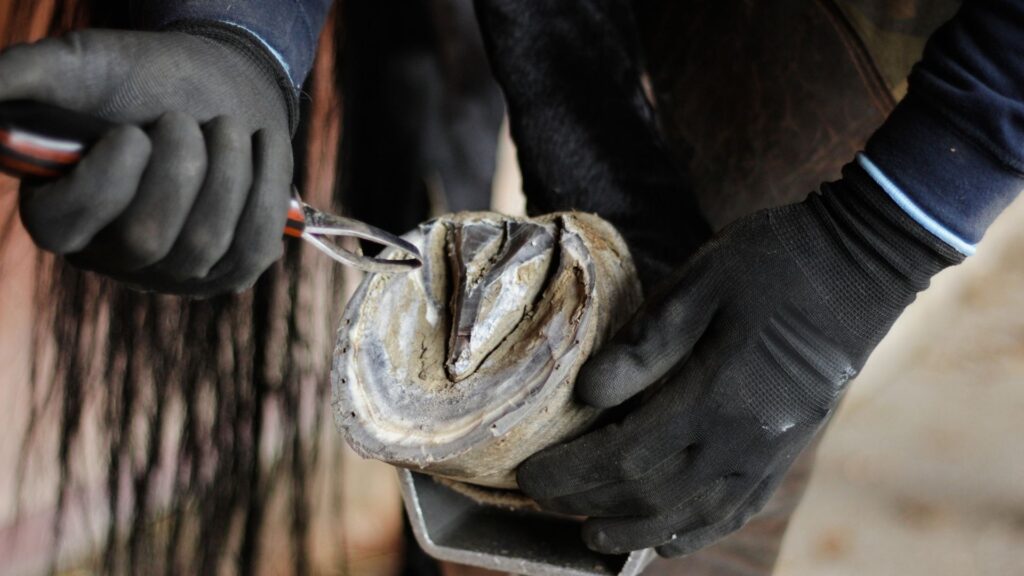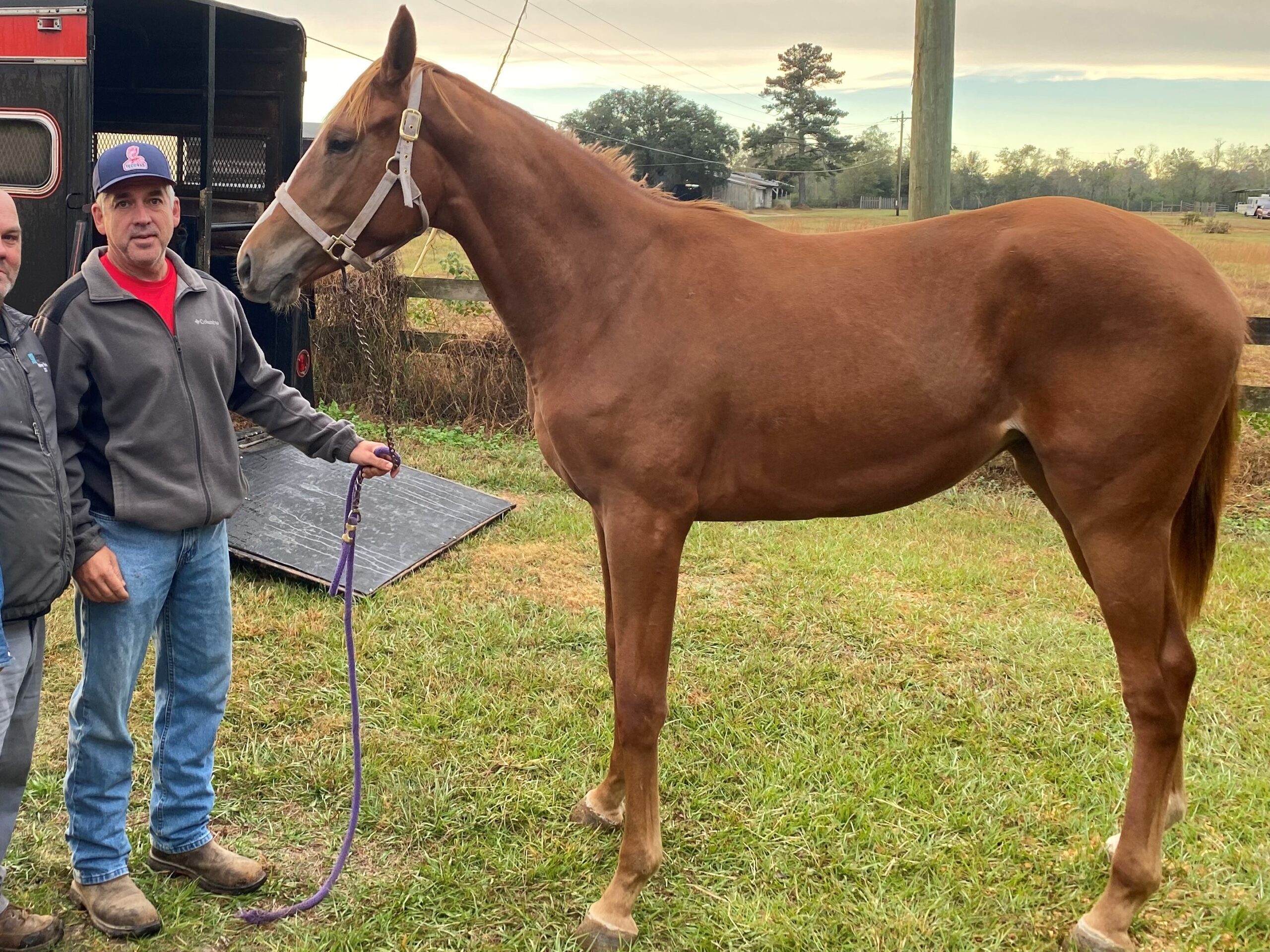Last updated: June 21, 2025
Any links on this page that lead to products on Amazon are affiliate links and I earn a commission if you make a purchase. Thanks in advance – I really appreciate it!
Laminitis is a serious hoof condition that can severely impact your horse’s health—and even become life-threatening without timely prevention. This painful inflammatory condition affecting the horse’s hoof can lead to devastating consequences, ranging from chronic lameness to euthanasia.
While treating laminitis is crucial, prevention remains the ultimate goal. Key methods like dietary management and early detection of warning signs can play a vital role in reducing your horse’s risk. This guide explores actionable strategies to promote hoof health and prevent laminitis effectively.

What is Laminitis in Horses?
Laminitis is a painful condition that affects the hooves of horses, disrupting their ability to walk and move comfortably. It occurs when the laminae—the connective tissue that secures the hoof wall to the bone inside the hoof—becomes inflamed. This inflammation weakens the bond, causing instability and intense pain.
Here is an analogy that I hope makes this complex concept easier to understand, think of the laminae as Velcro strips that attach the horse’s hoof to the underlying bone. In a healthy hoof, these Velcro strips are strong and secure, holding everything firmly in place.
However, when laminitis occurs, these strips become inflamed and weakened, losing their grip. This instability can cause the hoof to detach from the bone, leading to pain and structural damage. By visualizing the laminae in this way, readers can better grasp the severity of laminitis and the importance of prevention

This condition is not just painful but can also lead to long-term lameness or even life-threatening complications. Understanding laminitis is crucial for recognizing its early signs and taking preventative action. For a deeper dive into the condition, visit UC Davis Center for Equine Health on Laminitis.
Risk Factors for Laminitis in Horses
Laminitis can stem from several factors, many of which are preventable with proper care. Here’s a detailed look at common causes and actionable strategies to protect your horse:
1. Equine Metabolic Syndrome (EMS)
- What It Is: EMS is a condition involving insulin resistance, obesity, and hormonal imbalances.
- How It Contributes: Horses with EMS are at higher risk of developing laminitis due to poor blood sugar regulation.
- What You Can Do: Work with your veterinarian to create a tailored diet and exercise plan. Explore the detailed guide on EMS from Michigan State University.Explore Michigan State.
2. Excessive Carbohydrate Intake
- What It Is: Overconsumption of sugars and starches, often found in lush pastures or grain-heavy diets.
- How It Contributes: Carbohydrate overload disrupts gut bacteria, leading to inflammation and laminitis.
- What You Can Do: Limit access to sugary feeds and transition diets gradually to prevent gut imbalance.

3. Obesity
- What It Is: Excess body weight often combined with hormonal issues like insulin resistance.
- How It Contributes: Obese horses place additional strain on their hooves, increasing their susceptibility to laminitis.
- What You Can Do: Regularly monitor your horse’s weight and implement controlled feeding and exercise plans. Learn more from the University of Illinois.
4. Concussive Forces
- What It Is: Repeated impact on hard surfaces during exercise.
- How It Contributes: Continuous strain increases the risk of hoof inflammation and laminitis.
- What You Can Do: Avoid riding on hard, uneven surfaces, and provide soft, supportive footing. Read more about founder in horses.

5. Stress and Sudden Dietary Changes
- What It Is: Stress from transportation, environmental changes, or herd dynamics; abrupt diet changes disrupting gut health.
- How It Contributes: Stress and rapid diet shifts destabilize hormonal and digestive balance, heightening inflammation risks.
- What You Can Do: Maintain a consistent routine and introduce dietary changes gradually over several weeks.
6. Other Factors
- What They Are: Systemic illnesses, hormonal disorders like Cushing’s disease, and certain medications.
- How They Contribute: These conditions weaken overall health, increasing vulnerability to laminitis.
- What You Can Do: Schedule regular veterinary check-ups to identify and address underlying issues. Explore this University of New Hampshire article.
By understanding these risk factors and proactively addressing them, you can protect your horse from laminitis and support its long-term health.

How to Prevent Laminitis in Horses
Preventing laminitis involves more than just monitoring hoof health—it’s about taking proactive steps to manage your horse’s diet, weight, and exercise regimen. These practical strategies are designed to help horse owners minimize risk factors and support long-term equine well-being.

1. Manage Your Horse’s Diet
- Pasture Management: Limit access to lush pasture, especially for horses prone to EMS or obesity. Rotational grazing and controlled feeding practices are key to reducing carbohydrate intake and preventing pasture-associated laminitis. Oregon State University.
- Controlled Carbohydrate Intake: Choose feeds low in sugar and starch. Consult an equine nutritionist to ensure a balanced diet tailored to your horse’s needs. Avoid overfeeding grain, as this can lead to excessive carbohydrate intake and increase laminitis risk.
- Forage First: High-quality forage should form the foundation of your horse’s diet. Read our guide on Best Hay Practices for Equine Health.
- Weight Management: Maintain a healthy weight through controlled feeding and regular exercise. For horses needing additional energy, check out Horse Supplements for Weight Gain.
2. Exercise Plans to Reduce Laminitis Risk in Horses
Encourage Regular Turnout
Daily turnout encourages natural movement and improves blood circulation in the hooves. For horses prone to laminitis, ensure turnout areas are free of uneven terrain or hard surfaces that can exacerbate hoof stress.
- Ideal Environment: Turnouts on soft, well-maintained footing allow your horse to move naturally without excess strain on the hooves. Gentle inclines can also help improve circulation and support healthy weight loss for overweight horses.
- Poor Environment: Hard, uneven surfaces, such as gravel or compacted dirt roads, increase concussion on the hooves and can exacerbate laminitis risk. Avoid forcing at-risk horses to work on such terrain.
Controlled Exercise
Regular, appropriate exercise is crucial in preventing laminitis. However, not all exercise environments are suitable for at-risk horses. For example:

Create Tailored Exercise Plans
Create an exercise regimen tailored to your horse’s age, fitness level, and health condition. For example:
- For Overweight Horses: Start with 15–20 minutes of hand-walking on soft ground daily, gradually increasing the duration as fitness improves. Introduce light lunging on sandy footing or slow trotting in a controlled arena for added cardio benefits.
- For Horses Recovering from Laminitis: Focus on walking exercises to stimulate blood flow without overloading the hooves. Short, frequent sessions (5–10 minutes) of hand-walking multiple times a day can be more beneficial than prolonged exercise.
- For Active Horses: Incorporate interval training, such as alternating between slow trotting and walking on soft, even ground. This helps build stamina without overstraining the hooves.
While creating a tailored program requires time and effort, the long-term benefits for your horse’s health make it well worth the investment.

3. Hoof Care for Laminitis Prevention
- Regular Trimming and Shoeing: Schedule farrier visits every 4–8 weeks to ensure proper hoof balance. Correct trimming prevents stress on the sensitive laminae. Refer to our Hoof Supplements Buyer’s Guide for tips on supporting hoof health.
- Corrective Shoeing: Address hoof imbalances or conformation issues with corrective shoeing to distribute weight evenly and reduce strain.
- Environmental Management: Provide clean, dry footing in stalls and paddocks to minimize exposure to bacteria and moisture that can weaken hooves.
4. Early Detection and Monitoring
- Regular Veterinary Check-ups: Schedule routine exams to monitor overall health and catch potential risk factors early.
- Body Condition Scoring: Regularly assess your horse’s condition to maintain a healthy weight.
- Metabolic Testing: Conduct testing to assess insulin sensitivity, especially for horses prone to EMS or with a history of laminitis.
- Advanced Diagnostics: Tools like thermal imaging and hoof ultrasound can detect inflammation and blood flow issues before clinical signs appear. National Institutes of Health
- Know Your Horse: Be attentive to subtle changes in behavior, gait, or hoof condition, as these can signal early warning signs.

Recognizing Early Signs of Laminitis in Horses
Spotting laminitis early is essential to prevent long-term damage to your horse’s hooves. From heat in the hooves to changes in gait, learning to recognize the subtle symptoms can help you act swiftly to protect your horse’s health.
Bounding Digital Pulse:
- What it is: A strong or bounding digital pulse in the fetlock is an early indicator of inflammation in the hoof.
- How to check: Use your fingertips to feel along the back of the fetlock. A bounding digital pulse feels strong and noticeable, unlike the faint, subtle pulse you normally feel in a healthy horse.
- Why it matters: This indicates increased blood flow due to inflammation and is often an early sign of laminitis.
Heat in the Hooves:
- What to look for: Consistently warmer-than-usual hooves when touched, particularly around the coronary band.
- How to assess: Compare the warmth of your horse’s hooves with others in the herd or different parts of the same hoof. Persistent heat signals inflammation.
- Pain on Hoof Testers: Sensitivity to pressure can pinpoint areas of pain in the hoofs.
Research shows that hooves feeling consistently warmer than usual on both sides for over 12 hours may indicate a higher risk of laminitis developing within the next day or two. (Source: “Can changes in hoof wall temperature and digital pulse pressure be used to predict laminitis onset?”
Reluctance to Move:
- Description: A stiff or cautious gait, where the horse seems unwilling to bear weight on one or more hooves, can signal pain in the hoof structure.
- What to observe: Look for shortened strides or hesitancy when walking on hard or uneven surfaces.
Note: If your horse shows signs of discomfort or changes in gait, consult a veterinarian immediately for evaluation.

My Experience with Laminitis
I had a pony who was like a family member. When he began showing signs of laminitis, including a pounding digital pulse and reluctance to move, I immediately consulted my veterinarian. Together, we came up with a plan to address his condition, focusing on controlled grazing, weight management, and tailored exercise.
One of the biggest challenges was maintaining consistency in his diet while avoiding lush pastures. To tackle this, I introduced a grazing muzzle, which proved effective. Another hurdle was ensuring his turnout areas had soft, supportive footing to minimize hoof strain. Seeing my pony improve with consistent care was a rewarding journey that deepened my appreciation for proactive management.
FAQs About Laminitis in Horses
What are the first signs of laminitis in horses?
Early signs include heat in the hooves, a bounding digital pulse, reluctance to move, and changes in gait.
Can laminitis in horses be cured?
While laminitis can be managed and treated, it’s often a lifelong condition requiring ongoing care and monitoring.
How does diet affect laminitis risk in horses?
Diet plays a crucial role; high-sugar feeds and lush pastures increase laminitis risk, while controlled carbohydrate intake reduces it.
What type of exercise is best for horses prone to laminitis?
Low-impact exercises like hand-walking and light lunging on soft footing are ideal for improving circulation without straining the hooves.
How often should a farrier check a horse at risk of laminitis?
Regular farrier visits every 4–8 weeks are essential to maintain proper hoof balance and reduce stress on the laminae.

Conclusion: Protect Your Horse from Laminitis
Preventing laminitis is about more than just avoiding a crisis—it’s about ensuring your horse thrives. By catching the warning signs early and taking preventive action, you can give your horse the best chance at a healthy, laminitis-free life.
Together, we can help our horses live healthier, laminitis-free lives. Have you tried specific strategies, like rotational grazing, to prevent laminitis? Share your experiences and insights in the comments below and help fellow horse owners discover what works best!
Explore More
- Essential Vitamins and Minerals for Equine Health:
- “Learn how balanced nutrition supports your horse’s overall health, from hoof integrity to a shiny coat.”
- Hoof Pain in Horses: Causes, Treatment, and Care:
- “Explore common hoof issues, their symptoms, and effective treatments to ensure your horse stays sound and comfortable.”
- Horse Skin Conditions: Prevention, Treatment, and Care:
- “Tips and strategies for maintaining your horse’s skin and coat health, addressing seasonal and environmental challenges.”

About the Author: Miles Henry
Lifelong Horseman | Racehorse Owner | Published Author
Miles Henry brings over 25 years of hands-on experience training and owning Thoroughbred racehorses. Raised with Quarter Horses and Appaloosas, he’s spent a lifetime learning from horses—on the track, in the barn, and in the field. Today, he runs a small but successful racing stable in Louisiana and shares real-world insights on HorseRacingSense.com, helping horse owners, fans, and bettors navigate the sport with confidence.
📚 Books: View Miles’s books on Amazon »
🎧 Podcast Guest: Animal Tales Ep. 32 |
YouTube Interview
📩 Newsletter: Sign up for racing tips and horse care advice »
🔗 Follow Miles:
Twitter |
Facebook |
YouTube

